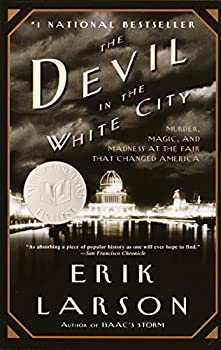
by Erik Larson, 2003
Heard this book mentioned by Karen, our Old Town Library Book Club leader. True story about the building of the World’s Columbian Exposition, a world’s fair, in Chicago in 1893, and a psychopathic serial killer, H. H. Holmes. The fair is completed against all odds: Architects not completing their designs on time; Extreme cold, snow, wind, rain; Labor unrest; Deaths and illness, etc. The fair opens and is awe-inspiring. It included the first Ferris Wheel, designed by George W. G. Ferris in an attempt to “out-Eiffel” the Eiffel Tower of the Paris World’s Fair. His design was approved, finally, after his third submission of the idea: “…this wheel would carry thirty-six cars, each about the size of a Pullman, each holding sixty people and equipped with its own lunch counter, and how when filled to capacity the wheel would propel 2,160 people at a time three hundred feet into the sky over Jackson Park, a bit higher than the crown of the now six-year-old statue of Liberty.” Miraculously, it was built and it worked and was safe and withstood extremely high winds. The entire fair was built in an amazingly short period of time. The main architect and leader, Daniel Hudson Burnham, should be given most of the credit. He was the one who led the charge and coordinated all of the thousands of details to pull off the building of this amazing world’s fair. The story of how he accomplished this is expertly told by Erik Larson.
At the same time, an extremely evil man, Herman Webster Mudgett, begins his grisly murders. He charms young women into trusting him, falling in love with him, and then they disappear. He is a doctor by training and goes by the name of H. H. Holmes. He builds an ugly hotel near the World’s Fair, full of gas pipes, a vault, and strange rooms. He only allows single women to stay there. Many disappear without a trace. No investigations are ever conducted. He lies convincingly about everything. He never paid the workers who built the hotel. He just fired them and hired new ones, so no one ever got the full drift of what he was doing. It isn’t until Fidelity Mutual Life Insurance Company investigates the suspicious death of a policy holder, along with the talented detective-work of Frank Geyer, that this monster is finally brought to justice and executed in May of 1896. They don’t know how many people he murdered; it could number in the hundreds. When they investigated the cellar of the hotel in Chicago, they found:
…a vat of acid with eight ribs and part of a skull settled at the bottom; mounds of quicklime; a large kiln; a dissection table stained with what seemed to be blood. They found surgical tools and charred high-heeled shoes.
And more bones:
Eighteen ribs from the torso of a child.
Several vertebrae.
A bone from a foot.
One shoulder blade.
One hip socket.
Articles of clothing emerged from walls and from pits of ash and quicklime, including a girl’s dress and bloodstained overalls. Human hair clotted a stovepipe. The searchers unearthed two buried vaults full of quicklime and human remains.
When he is hung and then buried, they filled his coffin with cement and then inserted his coffin in a double grave filled with cement. His disorder is called antisocial personality disorder.
Very interesting book about urban life in the late 1800s. Loved the details about the building of the fair. Loved the architects and their personal stories. The murderer’s story was shocking; that someone so evil could exist and could get away with murder for so long.